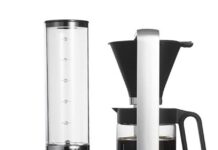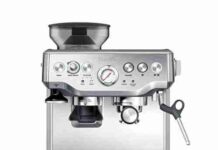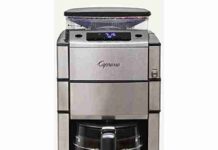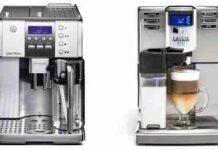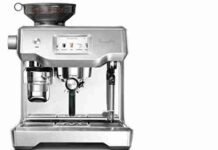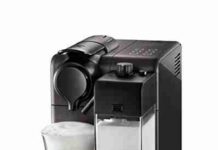Coffee lovers rejoice! We’ve all experienced that dreaded moment when our beloved Keurig coffee machine starts brewing at a sluggish pace or worse, starts spitting out lukewarm coffee. Fear not, for we have the solution to restore your Keurig to its former glory. In this article, we will guide you through the process of descaling your Keurig coffee machine, ensuring that it performs at its best and delivers that piping hot cup of Joe we all crave. So sit back, relax, and let us show you the way to a perfectly brewed cup of coffee every time.
Understanding the Descaling Process
What is descaling?
Descaling is the process of removing mineral deposits, or scale, that build up over time in your Keurig coffee machine. These deposits are a result of the minerals present in the water you use to brew your coffee. Descaling involves using a descaling solution, such as vinegar or a Keurig descaling solution, to break down and remove these mineral deposits, ensuring that your Keurig machine continues to function properly.
Why is descaling necessary?
Descaling is necessary to maintain the performance and longevity of your Keurig coffee machine. Over time, mineral deposits can clog the internal components of the machine, such as the water lines and heating elements, leading to issues such as slower brewing times, incomplete brewing cycles, and even machine malfunctions. Regular descaling helps prevent these problems, ensuring that your Keurig machine consistently delivers a delicious cup of coffee.
How often should you descale your Keurig coffee machine?
The frequency of descaling can vary depending on the quality of your water and how often you use your Keurig machine. As a general guideline, Keurig recommends descaling every three to six months. However, if you notice any signs of scaling, such as slower brewing or a change in the taste of your coffee, it may be necessary to descale more frequently. It’s best to follow the manufacturer’s instructions and monitor your machine’s performance to determine the ideal descaling schedule for your specific situation.
Preparing for Descaling
Gather the necessary supplies
Before you begin the descaling process, it’s important to gather all the necessary supplies. These typically include a descaling solution, a clean cloth or sponge, a paperclip or needle, and clean water. Having everything ready beforehand will make the descaling process smoother and more efficient.
Select a descaling solution
There are several options for descaling solutions, including vinegar, citric acid, Keurig descaling solution, and commercial descaling products specifically designed for coffee machines. Each option has its pros and cons, so consider factors such as availability, affordability, and personal preference when choosing your descaling solution.
Check the manufacturer’s instructions
Before you start descaling, it’s essential to consult your Keurig machine’s instruction manual or the manufacturer’s guidelines. Different models may have specific instructions or descaling processes, so it’s crucial to familiarize yourself with the recommended steps and precautions to ensure that you descale your machine properly.
Empty and clean the water reservoir
Before descaling, you need to empty the water reservoir and remove any residual water or coffee grounds. This step helps prevent any unwanted debris from mixing with the descaling solution and ensures that the solution can effectively remove scale from the reservoir. Additionally, wipe down the reservoir’s interior and exterior with a clean cloth or sponge to remove any residue.
Descaling Step-by-Step Guide
Now that you’re fully prepared, let’s delve into the step-by-step guide on how to descale your Keurig coffee machine:
Turn off and unplug the Keurig machine
First, make sure to turn off your Keurig machine and unplug it from the power source. This precaution is important for your safety and to avoid any electrical mishaps during the descaling process.
Disassemble and clean removable parts
Remove any detachable parts, such as the drip tray, K-Cup holder, and the water filter if applicable. Thoroughly clean these parts with warm, soapy water. For any stubborn residue, you can use a soft brush or a toothbrush. Rinse the parts thoroughly and set them aside to dry.
Mix the descaling solution with water
Follow the instructions on your selected descaling solution to determine the appropriate ratio of solution to water. Different solutions may have different dilution ratios, so ensure you measure accurately. Mix the solution and water in a container that is large enough to fit the water reservoir.
Fill the water reservoir with the solution
Next, pour the descaling solution and water mixture into the water reservoir of your Keurig machine. Be careful not to overfill the reservoir. If necessary, refer to the manufacturer’s instructions for the specific fill level recommended for your model.
Start the brewing process without a K-Cup
Place a large mug or container on the drip tray to collect the descaling solution. Make sure there is enough space for the solution to flow freely without overflowing. Start the brewing process without inserting a K-Cup, choosing the largest cup size available. This will allow the descaling solution to cycle through the machine.
Let the solution sit in the machine
Once the brewing cycle is complete, leave the descaling solution in the machine for about 15 minutes to allow it to effectively dissolve and remove the mineral deposits. This resting period gives the solution enough time to break down the scale and ensures a thorough descaling process.
Flush the machine with clean water
After the 15-minute resting period, remove the mug or container from the drip tray. Refill the water reservoir with clean water and place an empty container on the drip tray. Start the brewing process again without a K-Cup, choosing the largest cup size. Allow the clean water to cycle through the machine, thoroughly rinsing out any leftover descaling solution and mineral deposits.
Wipe down the exterior of the Keurig
While your Keurig machine is rinsing, take the opportunity to wipe down the exterior surfaces with a clean, damp cloth or sponge. Pay close attention to any areas that may have come into contact with the descaling solution. This step helps remove any residue or odor from the descaling process and leaves your machine looking clean and fresh.
Reassemble the cleaned parts
Once the rinsing cycle is complete, carefully reassemble all the cleaned removable parts that were previously removed. Ensure everything is securely in place and properly aligned. This step is essential for the optimal functioning of your Keurig machine.
Prime and test the Keurig machine
Before using your Keurig to brew a fresh cup of coffee, it’s important to prime the machine. Fill the water reservoir with clean water and allow the machine to heat up. Once the machine is ready, start a brewing cycle with a fresh K-Cup to ensure that everything is operating as expected. Congratulations! Your Keurig machine is now descaled and ready to brew your favorite cup of coffee.
Alternative Descaling Methods
While the descaling process outlined above is the most common and recommended method, there are alternative methods you can consider. Here are a few popular alternatives:
Using vinegar as a descaling agent
Vinegar is a readily available household item that can effectively descale your Keurig machine. Mix equal parts of white vinegar and water, then follow the same descaling process as outlined earlier. However, it’s important to note that the strong odor of vinegar may linger even after rinsing, so be prepared for this additional step of removing any lingering smell.
Using citric acid as a descaling agent
Citric acid is another natural descaling agent that can effectively remove mineral deposits from your Keurig machine. Mix about 1 tablespoon of citric acid with 4 cups of water, then follow the same descaling steps outlined earlier. Citric acid is often preferred over vinegar due to its milder scent.
Using Keurig descaling solution
Keurig descaling solution is a commercial product specifically designed for descaling Keurig coffee machines. It is formulated to effectively remove scale buildup while being safe for your machine and leaving behind minimal residue or odor. Follow the instructions on the descaling solution packaging for the correct dilution ratio and descaling process.
Using commercial descaling products
There are various commercial descaling products available on the market that are specifically formulated for coffee machines. These products offer convenience and may come in different forms such as tablets, powders, or liquids. Always follow the instructions provided by the manufacturer of the descaling product to ensure effective descaling.
Maintenance Tips to Prevent Scaling
To prolong the time between descaling and maintain the optimal performance of your Keurig coffee machine, here are some essential maintenance tips to help prevent scaling:
Use filtered or bottled water
Using filtered or bottled water with low mineral content can significantly reduce the formation of scale in your Keurig machine. This is because minerals are the primary culprits behind scale buildup. Avoid using hard water or water with high mineral content, as this will accelerate scale formation.
Regularly clean the water reservoir
Regularly clean and empty the water reservoir of your Keurig machine. Residual water can stagnate and promote the growth of bacteria or mold, which can affect both the taste of your coffee and the overall hygiene of your machine. Cleaning the reservoir helps maintain freshness and cleanliness.
Keep the Keurig machine dry when not in use
After each use, ensure that your Keurig machine is thoroughly dried. Moisture can create an environment for mold or bacteria growth, as well as accelerate corrosion of internal components. Wipe down any external surfaces that may have come into contact with water, and leave the machine open to dry before storing it away.
Avoid using oily or sweetened beverages
While Keurig machines are designed to handle a variety of beverages, frequent use of oily or sweetened beverages can leave residue behind that can contribute to scaling. To minimize the risk of scale buildup, it’s best to primarily use non-oily, unflavored beverages such as coffee or tea.
Inspect and clean the needle puncture
The needle puncture is responsible for piercing the K-Cup and allowing water to flow through for brewing. Over time, coffee grounds and residue can accumulate on the needle, leading to clogs or incomplete puncturing. Regularly inspect and clean the needle puncture to ensure a smooth brewing process and reduce the risk of blockages.
Troubleshooting Common Descaling Issues
While descaling can solve many problems associated with scale buildup, you may encounter a few issues along the way. Here are some common descaling issues and their potential solutions:
Machine not descaling properly
If your Keurig machine is not descaling as expected, ensure that you have followed all the recommended steps accurately. Double-check the dilution ratio of the descaling solution, the water reservoir fill level, and the brewing cycle duration. If the issue persists, consult the manufacturer’s troubleshooting guide or contact customer support for assistance.
Unpleasant taste or smell after descaling
In some cases, you may notice an unpleasant taste or smell lingering after the descaling process. This can be caused by residual descaling solution or mineral deposits that were not completely removed. Ensure that you thoroughly rinse the machine during the rinsing step to remove any remaining descaling solution or mineral residue.
Error messages during the descaling process
If your Keurig machine displays error messages during the descaling process, refer to the manufacturer’s instruction manual or troubleshooting guide. Error messages can indicate various issues, such as water flow problems or sensor malfunctions. Following the recommended troubleshooting steps can help identify and resolve the specific error.
Benefits of Regular Descaling
Regularly descaling your Keurig coffee machine offers several benefits that can enhance your brewing experience and extend the lifespan of your machine:
Extended lifespan of the Keurig machine
Removing mineral deposits through descaling helps prevent clogs and malfunctions that can lead to costly repairs or the need for a replacement machine. By taking care of your Keurig machine and descaling it regularly, you can ensure it serves you well for many years.
Improved brewing performance
Scale buildup can impede the flow of water through the machine, resulting in slower brewing times and incomplete brewing cycles. Descaling clears the water lines and components, allowing for a smoother and more efficient brewing process. This results in faster brewing times, consistent cup sizes, and improved overall performance.
Enhanced taste and quality of coffee
Mineral deposits can affect the taste and quality of your coffee by altering the flavor profile and leaving behind an unpleasant aftertaste. Descaling removes these deposits, allowing your Keurig machine to brew coffee with its full flavor potential. By regularly descaling, you can ensure that each cup of coffee is as delicious and enjoyable as possible.
Safety Precautions during Descaling
While descaling your Keurig machine may seem like a straightforward process, it’s essential to prioritize safety. Here are some important safety precautions to keep in mind:
Read and follow the instructions carefully
Before descaling, thoroughly read and understand the instructions provided by the descaling solution manufacturer and the Keurig machine manufacturer. Following the recommended procedures and precautions will help ensure a safe and effective descaling process.
Use appropriate protective gear
When handling descaling solutions or cleaning agents, it may be necessary to use protective gear such as gloves or goggles. Some descaling solutions can be corrosive or irritate the skin, so take the necessary precautions to protect yourself.
Be cautious with hot surfaces and liquids
Throughout the descaling process, you may encounter hot surfaces and liquids. Exercise caution when handling these to avoid burns or scalds. Allow ample time for surfaces and liquids to cool down before touching or disposing of them.
Keep descaling agents out of reach of children and pets
Descaling solutions and cleaning agents can be harmful if ingested or come into contact with the eyes or skin. Store these products in a safe place out of reach of children and pets to prevent accidents or injuries.
Frequently Asked Questions (FAQs)
Can I use vinegar instead of descaling solution?
Yes, you can use vinegar as a natural alternative to a descaling solution. Mix equal parts of white vinegar and water, then follow the descaling process outlined earlier. However, be aware that the strong odor of vinegar may linger, requiring additional steps to remove the smell.
Why is it important to empty the water reservoir?
Emptying the water reservoir before descaling is important to prevent any residual water or coffee grounds from mixing with the descaling solution. This ensures that the solution can effectively remove scale from the reservoir, promoting a thorough descaling process.
Can I descale a Keurig machine without disassembling it?
While disassembling and cleaning removable parts helps achieve the most thorough descaling, it is possible to descale a Keurig machine without disassembling it. Follow the descaling process outlined earlier, paying close attention to the water reservoir, needle puncture, and thoroughly rinsing the machine.
How long does the descaling process take?
The duration of the descaling process can vary depending on factors such as the level of scale buildup and the descaling method used. On average, the entire descaling process can take between 30 minutes to an hour, including the resting and rinsing periods.
Can descaling fix a Keurig machine that is not working?
While descaling can resolve some issues caused by scale buildup, it may not fix all problems with a malfunctioning Keurig machine. If your machine continues to have issues after descaling, refer to the manufacturer’s troubleshooting guide or contact customer support for further assistance.
Conclusion
Descaling your Keurig coffee machine is a critical maintenance task that helps ensure its optimal performance and longevity. By understanding the descaling process, gathering the necessary supplies, and following the step-by-step guide, you can effectively remove mineral deposits and keep your machine running smoothly. Regular descaling, combined with proper maintenance and care, will result in extended lifespan, improved brewing performance, and delicious cups of coffee every time. Remember to follow safety precautions, explore alternative descaling methods if desired, and enjoy the benefits of a well-maintained Keurig machine. Cheers to a perfect cup of coffee!



